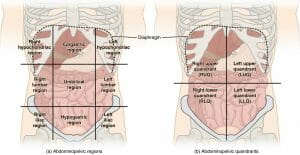Abdominal Cavity Definition
The abdominal cavity is a large cavity found in the torso of mammals between the thoracic cavity, which it is separated from by the thoracic diaphragm, and the pelvic cavity. A protective layer that is called the peritoneum, which plays a role in immunity, supporting organs, and fat storage, lines the abdominal cavity. As shown in the below diagram on the left, the abdominal cavity has been divided into nine different areas, where every organ doesn’t necessarily only occupy one. This division helps with the diagnosis of diseases based on the place where a person is experiencing abdominal pain.

Abdominal Cavity Organs
Our abdomen contains digestive, reproductive, and excretion organs. You can find some of them in the following diagram. Keep in mind that the rectum is considered as part of the pelvic cavity.

Stomach
A thick-walled digestive organ found on the left side of the abdomen that is divided into four regions: the cardia, fundus, body, and pylorus. It is continuous with the esophagus above it, which carries food from the mouth and passes through the diaphragm and into the stomach, and is followed by the first portion of the small intestine, called the duodenum. The stomach is the second site of digestion in humans after the mouth, and it serves to move food around within itself, mix it with gastric juices, and start the digestion of proteins.
Liver
This is the largest organ in the abdomen. It is found on the upper right side of it, right under the diaphragm. It has two lobes that are separated by a ligament. The liver plays a crucial role in our bodies as it maintains normal blood glucose levels, produces bile, and detoxifies blood.
Gall Bladder
The gall bladder is found below the liver and is connected to it. It stores and concentrates bile that is then sent to the duodenum when needed for fat digestion and absorption.
Spleen
The spleen is part of the immune system. Its functions include taking part in the production of white blood cells, storing platelets, and destroying dead red blood cells and harmful substances.
Pancreas
Part of the digestive system, the pancreas produces important digestive enzymes, as well as insulin and glucagon, which are crucial for the metabolism of carbohydrates in our bodies.
Small Intestine
The small intestine is found between the stomach and large intestine and is made up of three parts: the duodenum, jejunum, and ileum. It is a long, tube-shaped digestive organ where digestion and most absorption of nutrients take place
Large Intestine
The large intestine is the organ to which undigested material is sent. It is U-shaped, and is made up of the cecum, colon, rectum, anal canal, and appendix. Absorption of water and electrolytes and the formation of feces all occur here.
Kidneys
The two kidneys are found on either side of the abdomen. They play essential roles in the body, such as the detoxification of the blood, creation of urine, and maintenance of water and acid balance in the body. Attached to each kidney are tubes, called the ureters, which connect them to the urinary bladder. In addition to the kidneys’ functions, the adrenal glands found on the kidneys produce important hormones, such as norepinephrine and ADH.
Related Biology Terms
- Cranial cavity – The space found within a skull, which is occupied by the brain.
- Rib cage – A bony structure that has 12 pairs of ribs and that houses and protects the lungs and heart.
- Thoracic cavity – The space in which the rib cage, heart, and lungs are found in vertebrates.
- Trachea – The tube that carries air between the larynx and the lungs.
Quiz
1. In which organ in the abdominal cavity is bile stored?
A. The gall bladder
B. The kidneys
C. The pancreas
D. The small intestine
2. What separates the abdominal cavity from the thoracic cavity?
A. Esophagus
B. Diaphragm
C. Lungs
D. Ribcage
3. What is the purpose of dividing the abdominal cavity into nine regions?
A. Helps separate the digestive organs from the excretion organs
B. Helps with the diagnosis of ailments
C. So that every organ has a separate region
D. To make it easier for students to study human anatomy
4. Which of the following is the largest organ in the abdominal cavity?
A. Spleen
B. Stomach
C. Large intestine
D. Liver
